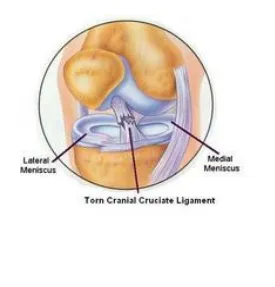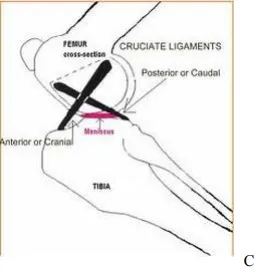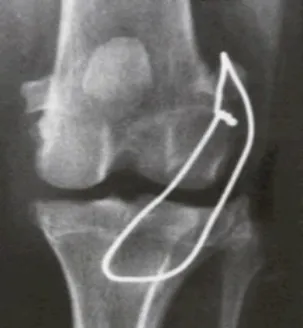Cruciate Ligaments and Meniscus
Cruciate Ligaments
The dog’s knee is formed by the joining of the flat ends of the lower part of the femur (the thigh bone) and the upper part of the tibia (shin bone). Because both bone ends are flat, a hinge is required to join them.
The cruciate ligaments are found inside the stifle (knee) joint of dogs and cats. Forming an X inside the knee joint, the cruciate ligaments are large and strong ligaments composed of hundreds of thin fibers woven together like a rope to join the femur to the tibia. Their function is to keep the knee joint stable and they prevent inappropriate movements within the knee joint including hyperextension and excessive internal rotation. Some dogs have weak ligaments, while others have strong ligaments that rupture from a severe stress. Heavy dogs with thin legs put significant stress on the cruciate ligaments.
Cruciate Ligament Tears and Rupture
Very active dogs (and cats) tear this ligament by turning their body quickly while the foot is firmly planted on the ground. The weight of the body twists the knee and a weakened ligament will give way. Sometimes the ligament ruptures when a dog plants the foot and pushes off very rapidly to start running. When a cruciate ligament tears, the dog experiences sudden pain and often holds his leg up. The dog may put the leg down, walking on the toes and then start using the leg again within a day or so, but will continue to limp for several weeks. Normally, at the end of several weeks, the initial pain subsides and the dog is willing to use its leg more as scar tissue is laid down splinting the joint and the inflammation and swelling go away; however, the joint will stay unstable
Longer term, when your dog plants the foot and puts weight on the leg, the tibia (shin bone) slides forward in relationship to the femur (thigh bone). As you can imagine, this can be painful as the joint cartilage wears down, leading to arthritis. This motion can also put excessive stress on the menisci (C shaped pieces of spongy cartilage within the knee joint), causing damage or tearing.
When the ligament completely ruptures, the dog cannot bear weight on the foot at all and will hold the leg up off the ground. A completely ruptured cruciate ligament will not heal.
Diagnosis
We can diagnose a ruptured cruciate ligament by feeling the bones of the femur and tibia moving abnormally where they form your dog's knee. Sometimes these are best felt while the dog is sedated and relaxed. There is a clicking feel and we can feel the bones slide over each other creating what is known as the “drawer movement.”
In some cases, where there is thickening of the ligaments, an X-ray of the knee is taken to see if there is arthritis, new bone growth around the joint, or if there is severe scarring, also known as the buttress sign (a very thick band of fibrous tissue that grows outside the joint in response to the instability.)
Treatment of Cruciate Ligament Injury
Strong Suture Placed Outside Knee
If there is an incomplete tear in the ligament, then rest and medication may be effective at keeping the dog comfortable and mobile. Pain relieving drugs (such as Previcox), drugs to help relieve the inflammation of the joint (such as Adequan Canine), physical therapy (Laser Therapy or swimming), and weight loss all help in the recovery. Some dogs with incomplete tears do require surgical intervention.
Complete ligament ruptures are usually treated with surgery, which involves using synthetic suture material, or a portion of adjacent fibrous tissue to basically re-create the ligament. These work well to stabilize the knee in most inactive dogs. If there is meniscal tear, we can remove the torn part of the meniscus. At Animal Hospital of Montgomery, we can do this type of cruciate surgery in our hospital.
In larger active dogs, over 60 pounds, other types of surgical treatment include fibular head transfer, Tibial Plateau Leveling Operation(TPLO) or the Tibial Tuberosity Advancement (TTA) can be done by a Board Certified Veterinary Orthopedic Surgeon either locally, in Birmingham, or in Auburn. These procedures require cutting and repositioning the bones to stabilize the knee.
If you don't treat your dog with a ruptured cruciate, severe arthritis will eventually develop and the opposite cruciate ligament may rupture in the other knee because of the extra weight being put on it. Dogs with a ruptured cruciate ligament will often rupture their other one at some time in their life.

Ligament repair using a tendon threaded through the
joint

Ruptured Ligament and Meniscal Tear\


